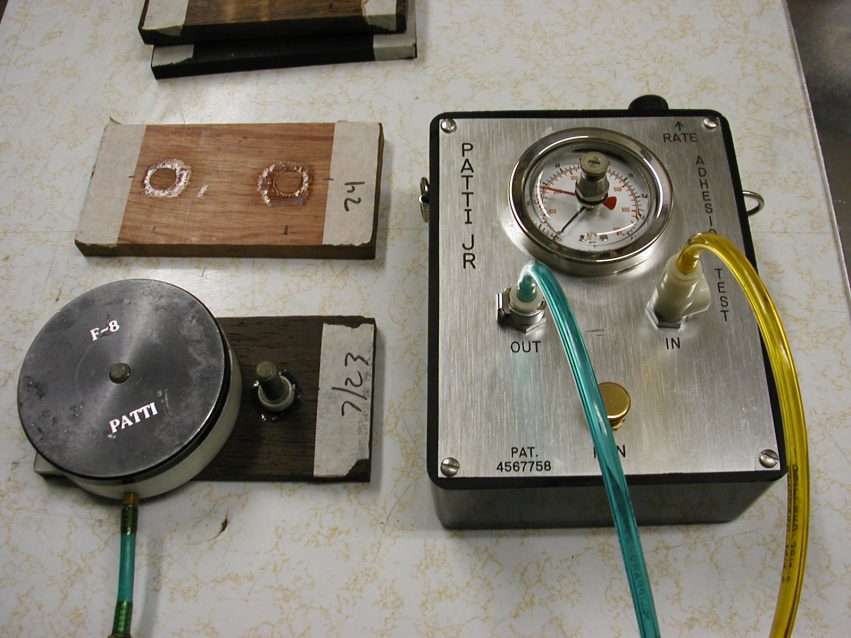
Woods of the World Epoxy Adhesion Testing
by Tom Pawlak — GBI Technical Advisor
Above: Epoxy’s adhesion to wood is the focus of this study of dozens of wood varieties from Africa and the Philippines.
We recently purchased a 154-piece wood sampler from Eisenbrand Inc., Torrance, California. The 3″ × 6″ × ½” specimens originated from points all around the world. Each specimen was provided with its common name, scientific name, and country of origin. There were several specimens we’d never heard of in this study of epoxy’s adhesion to wood.
The PATTI test uses compressed air to pull the stud from the surface. It records the force required to break the bond in pounds per square inch. In all cases tested, the epoxy held and the wood failed.
We thought it would be interesting to find out how well WEST SYSTEM® Epoxy adheres to the different wood species. The 3″ × 6″ samples were just large enough to accept two PATTI (pneumatic tensile test instrument) studs. Two results per species do not provide enough data for scientific conclusions but do give a good idea of what to expect. The samples were prepared for adhesion testing by sanding parallel to the grain with sharp 60-grit sandpaper. No solvents were used to remove any natural oils. All PATTI studs were glued in place using 105 Resin/206 Slow Hardener.

The following results are all woods from Africa and the Philippines. Epoxy’s adhesion to wood test results featuring woods from other parts of the world will be shared in future issues of Epoxyworks. The predominant failure mode for each species was wood failure.
Epoxy’s Adhesion to Wood in PSI
| Common name | Scientific name | Origin | Average psi | |
| 1 | African Wattle | Peltophorum africanum | Africa | 1218 |
| 2 | Afromosia | Afromosia elata | Africa | 1462 |
| 3 | Aniegre | Aninquera robusta | Africa | 1564 |
| 4 | Avodire | Turraeanthus africanus | Western Africa | 1258 |
| 5 | Black Limba | Terminalia spp. | Africa | 1666 |
| 6 | Bubinga | Guibourtia demueusei | Africa | 1930 |
| 7 | Boekenhout | Faurea saligna | Africa | 1544 |
| 8 | Camphor | Cinnamomum camphoratum | Africa | 1156 |
| 9 | Cape Blackwood | Acacia melanoxylon | Africa | 1340 |
| 10 | Ebony, Gabon | Diospyros spp. | Africa | 1564 |
| 11 | Imbuia | Phoebe parosa | Africa | 1564 |
| 12 | Iroko | Chlorphora excelsa | Africa | 1299 |
| 13 | Jacaranda | Jacaranda mimosifolia | Africa | 1462 |
| 14 | Leadwood | Combretum imberbe | Africa | 1340 |
| 15 | Monkey Thorn | Acacia galpinii | Africa | 1258 |
| 16 | Narra | Pterocarpus indicus | Philippines | 994 |
| 17 | Olive | Olea africana | Africa | 1605 |
| 18 | Padauk | Pterocarpus soyauxii | Africa | 994 |
| 19 | Paldao | Dracontomelum dao | Philippines | 1544 |
| 20 | Sapele | Entandophragma spp. | Africa | 1198 |
| 21 | Shedwa | Guibourtia spp. | Africa | 1584 |
| 22 | Silver Oak | Grevillea robusta | Africa | 1462 |
| 23 | Silver Terminalia | Terminalia sericea | Africa | 1340 |
| 24 | Stinkwood | Ocotea bullata | Africa | 1544 |
| 25 | Syringa | Melia azedarach | Africa | 1218 |
| 26 | Tambootie | Spyrotachys afr. | Africa | 2033 |
| 27 | Wenge | Milletia spp. | Africa | 1482 |
| 28 | White Limba | Terminalia amazonia | Africa | 1034 |
| 29 | Zebrawood | Microberlinia brazzavilensis | Africa | 1604 |






